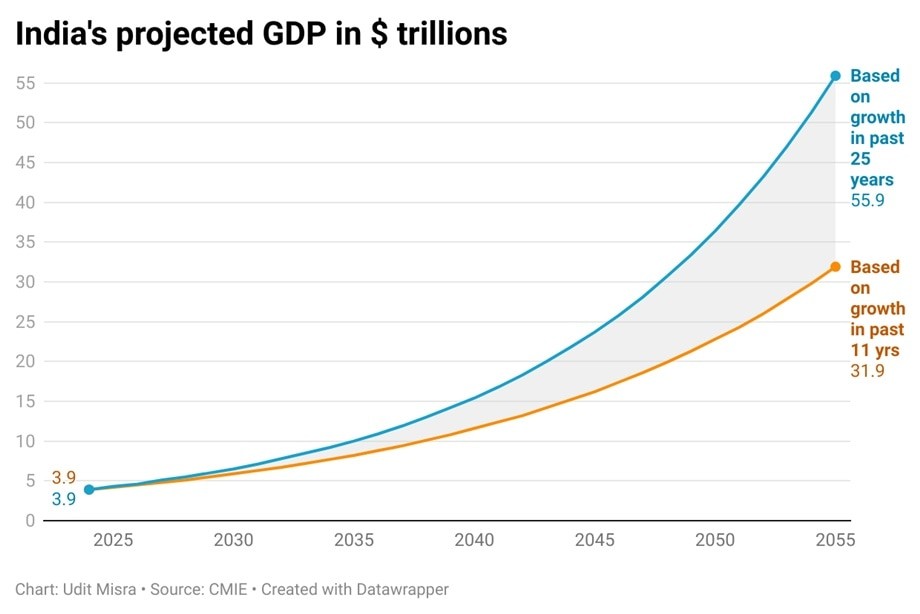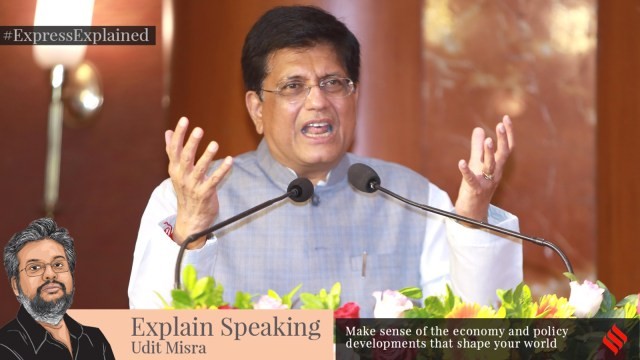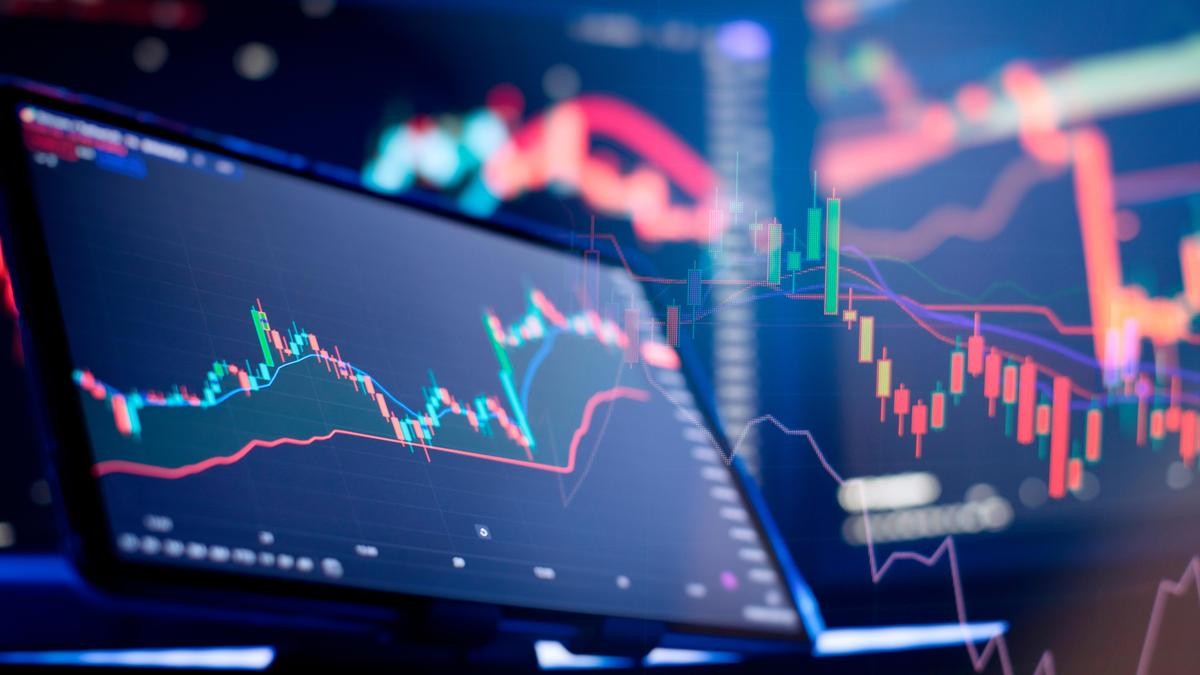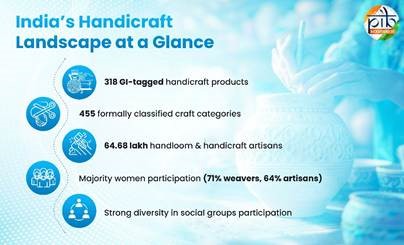Copyright infringement not intended
Picture Courtesy: Indian Express
Context:
Commerce and Industry Minister Piyush Goyal recently stated that India aims to become a $30 trillion economy in the next 20-25 years. Speaking at the Berlin Global Dialogue, he emphasized that India will approach trade deals with a long-term perspective, focusing on future economic potential rather than immediate pressures.
Current Status:
- India’s nominal GDP for the year ending March 2025 is estimated at ₹ 330.7 lakh crore (~US $3.87 trillion) at current exchange‑rates. (Source: PIB)
- In terms of purchasing‑power parity (PPP), India ranks among the top three globally.
- Real GDP growth in FY2024‑25 is estimated at around 4%–6.5%, with nominal GDP growth at approx. 9.8%.(Source: PIB)
- India has become the 4th largest economy globally (nominal GDP) and is projected to climb higher in ranking. (Source: PIB)

Picture Courtesy: Indian Express
What is GDP?
GDP (Gross Domestic Product) is the total monetary value of all goods and services produced within a country’s borders in a specific period, usually a year or a quarter.
It reflects the economic size, health, and productivity of a nation. Higher GDP generally indicates a stronger economy, more production, and higher income levels.
There are three main types of GDP:
- Nominal GDP – Measured at current market prices, not adjusted for inflation.
- Real GDP – Adjusted for inflation, reflects the true growth in production.
- GDP (PPP) – Purchasing Power Parity; adjusts for differences in price levels across countries to compare real living standards.
How GDP is measured?
There are three approaches to calculating GDP:
Production (or Output) Method
- Adds up the value of all goods and services produced in the economy.
- Formula:
- Example: Cars produced in India × market price per car.
Income Method
- Adds all incomes earned in the economy: wages, profits, rent, interest, and taxes minus subsidies.
- Formula:
Expenditure Method
- Adds all spending on final goods and services.
- Formula:

Where:
- C = Consumption by households
- I = Investment by businesses
- G = Government spending
- X = Exports
- M = Imports
Why GDP matters?
- Measures economic performance and growth trends.
- Helps governments and policymakers make decisions on fiscal and monetary policy.
- Indicates the standard of living and economic strength relative to other countries.
Multi-dimensional impact in achieving $30 trillion economy:
Economic Growth and Investment
- Sustained GDP Growth: Achieving $30 trillion requires India to maintain high annual growth (7–8% nominal GDP growth over 25 years).
- Domestic Investment: Boosting infrastructure, manufacturing, and technology sectors is crucial.
- Foreign Direct Investment (FDI): Attracting global capital will provide technology transfer, jobs, and market expansion.
Infrastructure and Urban Development
- Smart Cities & Transport: Efficient transport, energy, and digital infrastructure enhance productivity.
- Energy & Sustainability: Clean energy investments reduce costs and ensure long-term growth.
- Rural Development: Upgrading rural infrastructure connects more people to the economy.
Human Capital & Skill Development
- Education & Skill Building: Skilled workforce supports higher productivity and innovation.
- Healthcare & Well-being: A healthier population increases economic output and reduces lost labor days.
- Youth Empowerment: Engaging 50% of India’s population below 25 years ensures demographic dividend utilization.
Technological Advancement & Innovation
- Digital Economy: E-commerce, fintech, AI, and blockchain increase efficiency and global competitiveness.
- R&D Investments: Innovation in sectors like biotech, manufacturing, and space enhances global trade potential.
- Automation & Industry 4.0: Improves production efficiency while creating high-skill jobs.
Trade and Global Integration
- Exports Growth: Strengthening trade links with major economies boosts GDP in dollar terms.
- Strategic Partnerships: Bilateral and multilateral deals enhance India’s global economic footprint.
- Currency Management: Maintaining a stable rupee-dollar ratio supports nominal GDP growth in USD terms.
Financial Sector & Policy Stability
- Robust Banking & Capital Markets: Efficient credit flows support businesses and entrepreneurs.
- Fiscal Discipline & Reforms: Balanced budgets, tax reforms, and investment-friendly policies sustain growth.
- Monetary Policy: Inflation control and interest rate management stabilize economic expansion.
Social & Environmental Dimensions
- Inclusive Growth: Reducing income inequality ensures broad-based consumption and market expansion.
- Sustainability: Eco-friendly growth prevents resource depletion and long-term economic setbacks.
- Urban-Rural Synergy: Integrating rural economies into global supply chains maximizes potential.
Challenges:
- Sustaining Growth: Maintaining high GDP growth consistently over 25 years is difficult.
- Infrastructure Gaps: Poor transport, energy, and digital infrastructure can slow progress.
- Human Capital: Skill mismatches and health issues may reduce workforce productivity.
- Technology & Innovation: Low R&D and slow adoption of new tech can limit competitiveness.
- Policy & Regulation: Bureaucracy and fiscal challenges may hinder investments.
- Global Risks: Trade fluctuations and geopolitical tensions can impact growth.
- Environment: Climate change and resource constraints threaten sustainable development.
- Inequality: Unequal growth can limit domestic consumption and social cohesion.
Way Forward:
- Economic Reforms: Simplifying regulations, improving ease of doing business, and attracting foreign investment.
- Infrastructure Development: Investing in transport, energy, digital networks, and smart cities to boost productivity.
- Skill Development: Programs like Skill India and vocational training to enhance workforce capabilities.
- Technology & Innovation: Promoting R&D, startups, AI, and digital adoption through initiatives like Digital India.
- Fiscal & Monetary Policies: Maintaining macroeconomic stability, reducing deficits, and incentivizing private investment.
- Trade & Global Integration: Negotiating favourable trade deals and promoting exports to strengthen global presence.
- Sustainability Initiatives: Promoting green energy, water management, and climate-resilient projects.
- Social Inclusion: Schemes for rural development, healthcare, and financial inclusion to ensure equitable growth.
Conclusion:
Achieving a $30 trillion economy is an ambitious yet attainable goal for India, provided the country sustains high growth, strengthens infrastructure, invests in human capital, and fosters innovation. Strategic government measures, coupled with inclusive and sustainable development, will be crucial in overcoming challenges such as inequality, environmental constraints, and global uncertainties. With consistent policy support and long-term planning, India can transform into a major global economic powerhouse over the next 25 years.
Source: Indian Express
|
Practice Question
Q. Examine the feasibility of India achieving a $30 trillion economy in the next 25 years. (250 words)
|
Frequently Asked Questions (FAQs)
GDP (Gross Domestic Product) measures the total value of goods and services produced within a country. It indicates economic size, growth, and comparative global strength.
India’s GDP in rupees is converted into US dollars using the exchange rate. Nominal GDP is used for such international comparisons without adjusting for inflation.
Factors include sustained economic growth, demographic advantages, investment in infrastructure, technology and innovation, policy reforms, and a stable macroeconomic environment.













